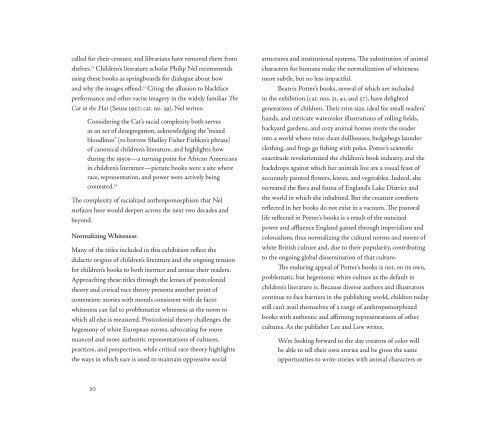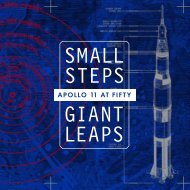Animals Are Us: Anthropomorphism in Children’s Literature; Celebrating the Peter J. Solomon Collection
Why do we tell stories to children through and about animals? Are there reasons why we shouldn’t? Animals Are Us invites explores these questions and more through influential historic examples of anthropomorphism in dialogue with contemporary books drawn from the collection of Peter J. Solomon (Harvard College Class of 1960, MBA 1963) and the holdings of Houghton Library. The exhibition invites you to engage critically with animal anthropomorphism, and delight in the artfulness of this enduring literary genre. Catalog of an exhibition on view at Houghton Library, Harvard University, September 1, 2021 - January 7, 2022.
Why do we tell stories to children through and about animals? Are there reasons why we shouldn’t? Animals Are Us invites explores these questions and more through influential historic examples of anthropomorphism in dialogue with contemporary books drawn from the collection of Peter J. Solomon (Harvard College Class of 1960, MBA 1963) and the holdings of Houghton Library. The exhibition invites you to engage critically with animal anthropomorphism, and delight in the artfulness of this enduring literary genre.
Catalog of an exhibition on view at Houghton Library, Harvard University, September 1, 2021 - January 7, 2022.
You also want an ePaper? Increase the reach of your titles
YUMPU automatically turns print PDFs into web optimized ePapers that Google loves.
called for <strong>the</strong>ir censure, and librarians have removed <strong>the</strong>m from<br />
shelves. 12 <strong>Children’s</strong> literature scholar Philip Nel recommends<br />
us<strong>in</strong>g <strong>the</strong>se books as spr<strong>in</strong>gboards for dialogue about how<br />
and why <strong>the</strong> images offend. 13 Cit<strong>in</strong>g <strong>the</strong> allusion to blackface<br />
performance and o<strong>the</strong>r racist imagery <strong>in</strong> <strong>the</strong> widely familiar The<br />
Cat <strong>in</strong> <strong>the</strong> Hat (Seuss 1957; cat. no. 39), Nel writes:<br />
Consider<strong>in</strong>g <strong>the</strong> Cat’s racial complexity both serves<br />
as an act of desegregation, acknowledg<strong>in</strong>g <strong>the</strong> “mixed<br />
bloodl<strong>in</strong>es” (to borrow Shelley Fisher Fishk<strong>in</strong>’s phrase)<br />
of canonical children’s literature, and highlights how<br />
dur<strong>in</strong>g <strong>the</strong> 1950s—a turn<strong>in</strong>g po<strong>in</strong>t for African Americans<br />
<strong>in</strong> children’s literature—picture books were a site where<br />
race, representation, and power were actively be<strong>in</strong>g<br />
contested. 14<br />
The complexity of racialized anthropomorphism that Nel<br />
surfaces here would deepen across <strong>the</strong> next two decades and<br />
beyond.<br />
Normaliz<strong>in</strong>g Whiteness<br />
Many of <strong>the</strong> titles <strong>in</strong>cluded <strong>in</strong> this exhibition reflect <strong>the</strong><br />
didactic orig<strong>in</strong>s of children’s literature and <strong>the</strong> ongo<strong>in</strong>g tension<br />
for children’s books to both <strong>in</strong>struct and amuse <strong>the</strong>ir readers.<br />
Approach<strong>in</strong>g <strong>the</strong>se titles through <strong>the</strong> lenses of postcolonial<br />
<strong>the</strong>ory and critical race <strong>the</strong>ory presents ano<strong>the</strong>r po<strong>in</strong>t of<br />
contention: stories with morals consistent with de facto<br />
whiteness can fail to problematize whiteness as <strong>the</strong> norm to<br />
which all else is measured. Postcolonial <strong>the</strong>ory challenges <strong>the</strong><br />
hegemony of white European norms, advocat<strong>in</strong>g for more<br />
nuanced and more au<strong>the</strong>ntic representations of cultures,<br />
practices, and perspectives, while critical race <strong>the</strong>ory highlights<br />
<strong>the</strong> ways <strong>in</strong> which race is used to ma<strong>in</strong>ta<strong>in</strong> oppressive social<br />
structures and <strong>in</strong>stitutional systems. The substitution of animal<br />
characters for humans make <strong>the</strong> normalization of whiteness<br />
more subtle, but no less impactful.<br />
Beatrix Potter’s books, several of which are <strong>in</strong>cluded<br />
<strong>in</strong> <strong>the</strong> exhibition (cat. nos. 21, 41, and 57), have delighted<br />
generations of children. Their trim size, ideal for small readers’<br />
hands, and <strong>in</strong>tricate watercolor illustrations of roll<strong>in</strong>g fields,<br />
backyard gardens, and cozy animal homes <strong>in</strong>vite <strong>the</strong> reader<br />
<strong>in</strong>to a world where mice clean dollhouses, hedgehogs launder<br />
cloth<strong>in</strong>g, and frogs go fish<strong>in</strong>g with poles. Potter’s scientific<br />
exactitude revolutionized <strong>the</strong> children’s book <strong>in</strong>dustry, and <strong>the</strong><br />
backdrops aga<strong>in</strong>st which her animals live are a visual feast of<br />
accurately pa<strong>in</strong>ted flowers, leaves, and vegetables. Indeed, she<br />
recreated <strong>the</strong> flora and fauna of England’s Lake District and<br />
<strong>the</strong> world <strong>in</strong> which she <strong>in</strong>habited. But <strong>the</strong> creature comforts<br />
reflected <strong>in</strong> her books do not exist <strong>in</strong> a vacuum. The pastoral<br />
life reflected <strong>in</strong> Potter’s books is a result of <strong>the</strong> outsized<br />
power and affluence England ga<strong>in</strong>ed through imperialism and<br />
colonialism, thus normaliz<strong>in</strong>g <strong>the</strong> cultural norms and mores of<br />
white British culture and, due to <strong>the</strong>ir popularity, contribut<strong>in</strong>g<br />
to <strong>the</strong> ongo<strong>in</strong>g global dissem<strong>in</strong>ation of that culture.<br />
The endur<strong>in</strong>g appeal of Potter’s books is not, on its own,<br />
problematic, but hegemonic white culture as <strong>the</strong> default <strong>in</strong><br />
children’s literature is. Because diverse authors and illustrators<br />
cont<strong>in</strong>ue to face barriers <strong>in</strong> <strong>the</strong> publish<strong>in</strong>g world, children today<br />
still can’t avail <strong>the</strong>mselves of a range of anthropomorphized<br />
books with au<strong>the</strong>ntic and affirm<strong>in</strong>g representations of o<strong>the</strong>r<br />
cultures. As <strong>the</strong> publisher Lee and Low writes,<br />
We’re look<strong>in</strong>g forward to <strong>the</strong> day creators of color will<br />
be able to tell <strong>the</strong>ir own stories and be given <strong>the</strong> same<br />
opportunities to write stories with animal characters or<br />
20



